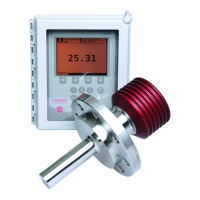7 Regular maintenance
59
7 Regular maintenance
The need for regular maintenance is minimal, due to the construction with no moving
parts, no mechanical adjustements, no trimpots and with a solid-state light source.
The following rules apply:
− Keep the sensor head and the Indicating transmitter clean and dry.
− Check that the ambient temperature is not above +45 °C (113 °F). The sensor head
should not be too hot to keep a hand on.
− If your refractometer has prism wash, check that it works, see Section 5.1.3.
7.1 Checking the sensor humidity level
The PR-23 sensor head has an internal humidity detector. The humidity reading can
be checked on the Indicating transmitter display, select 3 SENSOR STATUS from the Main
menu. Check the humidity reading once in every three months.
Increasing humidity level indicates either condensate forming in the sensor head (if
the process temperature is below ambient) or prism leakage. If the humidity reading
exceeds 30 %, replace the dryer. If the reading exceeds 50 %, check the prism seals.
Relative humidity exceeding 60 % will produce a diagnostic message HIGH SENSOR
HUMIDITY (see Section 8.1.7).
The dryer (desiccant) is a plastic package inside the sensor head cover, see Figure 7.1
(G). The dryer should be replaced at every service. The dryer cannot be reacti-
vated by any means, it must be replaced. You can order new dryer packages (drying
agents/desiccants), spare part number PR-9108, from either K-Patents or a K-Patents
representative.
For instructions on how to open the sensor head to replace the dryer, see Section 7.3.2.
7.2 Checking the prism and prism gaskets
Once a year check that the prism surface is smooth and clean and free of erosion and
small holes or digs. If the prism is scratched, eroded, or the gaskets seem to leak,
follow the procedure described in Section 7.3.3 to replace them.
Important: In 3-A certiied sensors, prism gasket replacement and other repairs
must be done by authorized K-Patents service centers only. If gaskets of 3-A certi-
ied sensors are replaced in the ield, the certiication is no more valid.
7.3 Disassembling and assembling the sensor
Warning! Wear appropriate protective clothing and be careful when removing the
sensor! Always check that the pipeline is empty before removing a sensor from the

